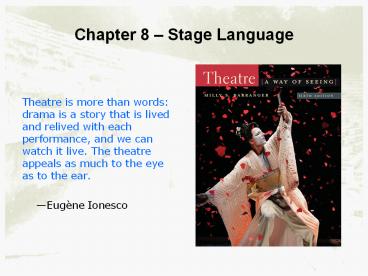Chapter 8 PowerPoint PPT Presentation
1 / 14
Title: Chapter 8
1
Chapter 8 Stage Language
- Theatre is more than words drama is a story that
is lived and relived with each performance, and
we can watch it live. The theatre appeals as much
to the eye as to the ear. - Eugène Ionesco
2
Chapter Summary
- Language for the theatre is special and complex.
- It organizes our perceptions of what is taking
place before us, forcing us into self-discovery
or radical changes of attitude. - It communicates meaning and activity to us in
ways that are verbal and nonverbal. - Stage language is a way of seeing that engages
our eyes, ears, and minds.
3
Words and Gestures
- In theatre, words connected to gesture
- Theatrical language selected and controlled
- Much more must happen in theatrical dialogue than
in ordinary life. - Language carefully arranged by playwright into
meaningful pattern - Drama is language under such high pressure of
feeling the words carry a necessary and immediate
connotation of gesture. - George Steiner
4
Verbal and Nonverbal Language
- Verbal and nonverbal signs and symbols used to
enhance meaning - Signs
- Direct physical relationship to what they
represent (thunder a sign of rain) - Symbols
- Arbitrary connection to what they represent
(American flag represents America)
5
Verbal and Nonverbal Language
- Chekhovs The Cherry Orchard
- Orchard a verbal symbol for passing of old life,
arrival of new social order - Sound of ax chopping down trees at plays end a
nonverbal sign representing destruction of
familys way of life
6
Types of Stage Language
- Monologue
- Extended, uninterrupted speech delivered by a
single character - Aside
- Brief remark by a character spoken directly to
the audience - Not overheard by others onstage
- Soliloquy
- A long speech delivered by a character, usually
alone onstage, for audience to overhear
7
Types of Stage Language Soliloquy in Shakespeare
- Uses soliloquy to take audience into characters
mind - How all occasions do inform against me
soliloquy from Hamlet - Precise argument reveals Hamlets intelligence.
- Length of speech reveals tendency toward delay.
- Soliloquy shows evolution from inactivity to
activity.
8
Types of Stage Language Sounds in The Cherry
Orchard
- Stage directions for speech delivered by elderly
valet at end of play indicate various sounds - Sounds of departure
- Breaking string
- Stroke of an ax
- Sound of string subsides into silence before ax
stroke is heard - Illustrates passing of valet, arrival of new,
aggressive world order
9
Types of Stage Language Brechts Gestic Language
- Gest refers to characters overall attitudes.
- Words should follow the gest of the speaker
- Brecht A language is gestic when it . . .
conveys particular attitudes adopted by the
speaker towards other men. - Example (from Caucasian Chalk Circle )
- Grusha reveals humanity by refusing to tug child
from circle. - Governors wife reveals grasping quality by
twice pulling the child from the circle.
10
Contemporary Trends in American Theatre Artauds
Theatre of Cruelty
- Antonin Artaud (18961948)
- French playwright and theorist
- Strong influence on 1960s American playwrights
- Rejected conventions of dialogue, plot, character
- Wanted to purge audience of hatred, violence,
cruelty - Provoked visceral response using nonverbal
effects - Shrill sounds
- Waves of light
- Violent physicalizations
- Unusual theatre spaces and staging
11
Contemporary Trends in American Theatre American
Playwrights of 1960s
- After Artaud, rejected stage language of
conversation that furthered plot, defined
character, explored social themes - Set out to assault senses with sounds, violent
images, nudity, physicalization - Intended to protest the political, military,
industrial, and cultural establishment - Avant-garde performance techniques eventually
appropriated by commercial theatre
12
Contemporary Trends in American Theatre David
Mamet
- Mamets characters are wordsmiths
- Speak in fragments
- Frequently profane
- Use language creatively to hustle other
characters - Mamet explores myths of American capitalism
- Characters want to connect, but know only the
deal. - Characters experience failure of business as a
moral model, become alienated from themselves.
13
Contemporary Trends in American Theatre Sam
Shepard
- Shows inner workings of modern American family
- Buried Child (1978)
- Themes
- Grown childrens complicated relationships with
parents - Quest for identity
- Evaporation of cherished values
14
Core Concepts
- Playwrights are among the most important of the
theatres image makers. - The writing of plays is their medium for
imitating human behavior and events. - Other theatre artists interpret the playwrights
text in the theatres three-dimensional space,
giving it shape, sound, color, rhythm, image,
activity, and human presence.

